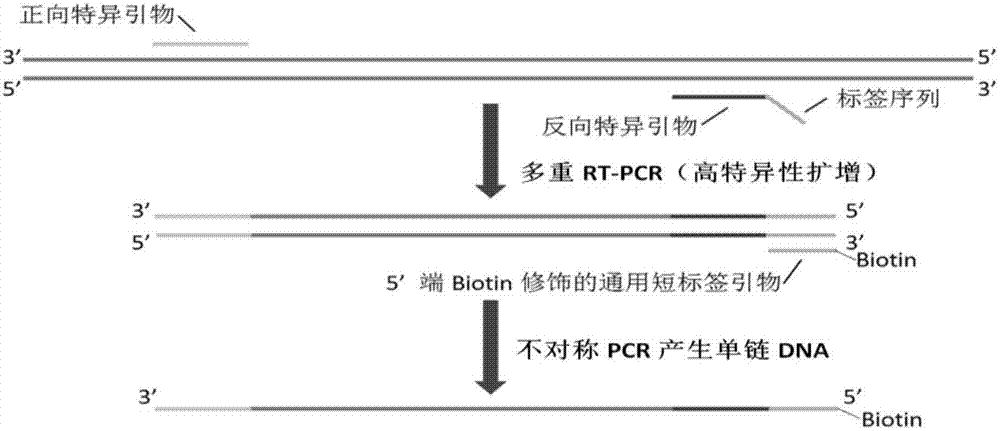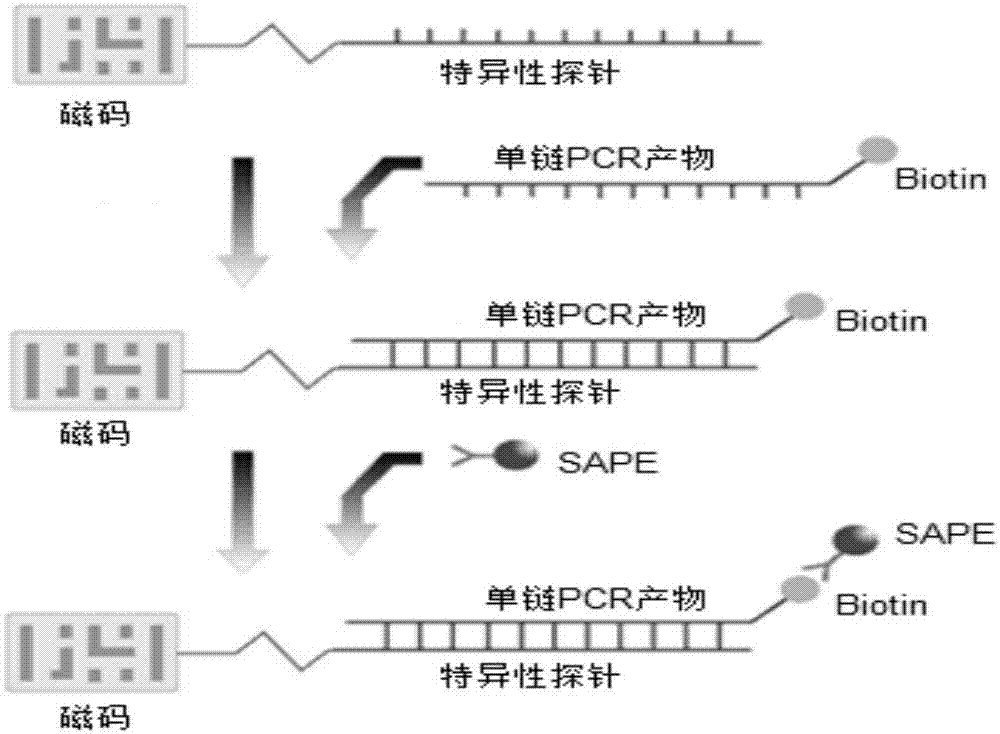Composition and kit for detecting 23 respiratory pathogens and detection method of kit
A composition and pathogen technology, applied in the field of nucleic acid detection, can solve the problems of increased sequencing cost, cumbersome operation, long time consumption, etc.
- Summary
- Abstract
- Description
- Claims
- Application Information
AI Technical Summary
Problems solved by technology
Method used
Image
Examples
Embodiment 1
[0072] This embodiment is a kit for detecting 23 kinds of respiratory pathogens, and the kit is based on liquid chip technology to detect pathogen nucleic acid. All nucleotide sequences of 23 pathogens were retrieved according to the database, homology analysis was carried out according to different pathogens, specific primers and universal primers, and specific probes were designed, and then the nucleic acid was extracted by using Pre-Nat instrument, and passed RT-PCR and After asymmetric PCR amplification (the principle of multiple amplification is as follows: figure 1 shown), the amplified product was hybridized with different magnetic beads bound to different probes, the hybridized product was incubated with SAPE, and then detected by the ABC BioCode3000 system (the hybridization detection principle is as follows figure 2 shown), so as to determine the type of pathogen contained in the sample.
[0073] The kit specifically includes a first reaction solution, a second rea...
Embodiment 2
[0083] In this embodiment, it is known that sample 1 contains influenza A virus H1N1, and the kit described in Example 1 is used for detection. The specific steps of the detection method are as follows:
[0084] a) The total nucleic acid in sample 1 is automatically extracted using a Pre-Nat instrument.
[0085] b) PCR reaction uses the extracted sample nucleic acid as a template, and uses the specific primers of SEQ ID NO.1 to SEQ ID NO.48 and the general primer shown in SEQ ID NO.73 to carry out the experiment, and the same template is added to two tubes for detection , add 10uL template to each tube. Among them, add 8uL of the first reaction solution and 2uL of mixed enzyme in the first tube; add 8uL of the second reaction solution and 2uL of mixed enzyme in the second group, and then put it into the BioCode3000 instrument for PCR reaction to obtain the PCR product . The reaction conditions are: 37°C for 2min; 50°C for 10min; 95°C for 10min; 95°C for 15s, 59°C for 30s, 72...
Embodiment 3
[0091] In this embodiment, it is known that samples 2 / 3 / 4 / 5 / 6 contain M.p, H7N9, C.p, HKU1 and H5 respectively, and are detected according to the detection method of the present invention. The specific steps are the same as in the second embodiment. The test results are as follows:
[0092] a) Determine the result based on the fluorescence signal value. When the fluorescent signal value of the calibration magnetic beads is 1000, and the fluorescent signal value of the internal standard reference product is >1000. At the same time, the magnetic bead detection fluorescence signal value of Mycoplasma pneumoniae (M.p) is 4475, and the other 23 targets have no non-specific signal >1000, confirming that the sample contains Mycoplasma pneumoniae (M.p);
[0093] b) Determine the result based on the fluorescence signal value. When the fluorescent signal value of the calibration magnetic beads is 1000, and the fluorescent signal value of the internal standard reference product is >10...
PUM
 Login to View More
Login to View More Abstract
Description
Claims
Application Information
 Login to View More
Login to View More - R&D
- Intellectual Property
- Life Sciences
- Materials
- Tech Scout
- Unparalleled Data Quality
- Higher Quality Content
- 60% Fewer Hallucinations
Browse by: Latest US Patents, China's latest patents, Technical Efficacy Thesaurus, Application Domain, Technology Topic, Popular Technical Reports.
© 2025 PatSnap. All rights reserved.Legal|Privacy policy|Modern Slavery Act Transparency Statement|Sitemap|About US| Contact US: help@patsnap.com



